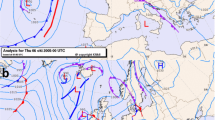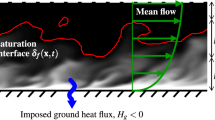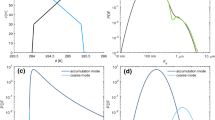Abstract
A two-dimensional boundary-layer model is described. The model is designed to predict and study the effects of meteorological changes on the formation and dissipation of fog and stratus. Radiational heat loss along with the transport of static energy, moisture and momentum are treated. Cloud droplet distributions are parameterized using a gamma distribution from which radiative properties and droplet fall velocities are computed. Turbulent exchange coefficients are calculated using the Monin-Obukhov theory of similitude which accounts for variations in atmospheric stability. Although the boundary-layer depth depends only on turbulent intensity during stable atmospheric conditions, its growth during unstable conditions is determined from the capping inversion's intensity and the amount of turbulence generated at the surface.
Several experiments are presented which demonstrate the effects of various meteorological parameters on the formation and duration of stratus and fog. Energy-budget analyses show the importance of each of the physical processes being modeled.
Although not new, radiative transfer processes are shown to be extremely important in the transfer of heat from the boundary layer and in the process of fog formation. Fog formation location is highly sensitive to the moisture content upstream, whereas changes in wind speed had much less effect in the variance of fog location.
Numerical experiments with other processes such as back radiation from the atmosphere, haze and cloud droplet population, are described and shown to have smaller effects.
Similar content being viewed by others
References
Atwater, M. A.: 1970,Investigation of the Radiation Balance for Polluted Layers of the Urban Environment, Ph.D Thesis, New York University, New York, 116 pp.
Barker, E. H. and Baxter, T. L.: 1975, ‘A Note on the Computations of Atmospheric Surface Layer Fluxes for Use in Numerical Modeling’,J. Appl. Meteorol. 14, 620–622.
Bornstein, R. D. and Robock, A. D.: 1976, ‘Effects of Variable and Unequal Time Steps for Advective and Diffusive Processes in Simulations of the Urban Boundary Layer’,Mon. Weather Rev.,104, 260–267.
Businger, J. A., Wyngaard, J. C., Izumi, Y., and Bradley, E. F.: 1971, ‘Flux-Profile Relationships in the Atmospheric Surface Layer’,J. Atmos. Sci. 28, 181–189.
Clarke, R. H.: 1970, ‘Recommended Methods for the Treatment of the Boundary Layer in Numerical Models’,Australian Meteorol. Mag. 18, 51–71.
Deardorff, J. W.: 1970, ‘Convectioe Velocity and Temperature Scales for the Unstable Planetary Boundary Layer and for Rayleigh Convection’,J. Atmos. Sci. 27, 1211–1213.
Deardorff, J. W., Willis, G. E., and Lilly, D. K.: 1969, ‘Laboratory Investigation of Non-Steady Penetrative Convection’,J. Fluid Mech.,35, 7–31.
Deirmendjian, D.: 1964, ‘Scattering and Polarization Properties of Water Clouds and Hazes in the Visible and Infrared’,Appl. Optics. 3, 187–196.
Emmons, G. and Montgomery, R. B.: 1947, ‘Note on the Physics of Fog Formation’,J. Meterol. 4, 206.
Estoque, M. A.: 1959, ‘A Preliminary Report on a Boundary Layer Numerical Experiment’,GRD Research Notes, AFCRC (ARDC),20, 1–29.
Estoque, M. A.: 1963, ‘A Numerical Model of the Atmospheric Boundary Layer’,J. Geophys. Res. 68, 1103–1113.
Fisher, E. L. and Caplan, P.: 1963, ‘An Experiment in Numerical Predictions of Fog and Stratus’,J. Atmos. Sci. 20, 425–431.
Funk, J. P.: 1962, ‘Radiative Flux Divergence in Radiation Fog’,Quart. J. Roy. Meteorol. Soc. 88, 233–249.
Gerrity, J. P., Jr.: 1967, ‘A Physical Numerical Model for the Prediction of Synoptic Scale Low Cloudiness’,Mon. Weather Rev. 95, 261–282.
Kraus, E. B.: 1972,Atmosphere-Ocean Interaction, Clarendon Press, Oxford.
Lenschow, D. H.: 1973, ‘Two Examples of Planetary Boundary Layer Modification Over the Great Lakes’,J. Atmos. Sci. 30, 568–581.
Lilly, D.: 1968, ‘Models of Cloud-Topped Mixed Layers Under a Strong Inversion’,Quart. J. Roy. Meteorol. Soc. 94, 292–309.
Long, P. E.: 1972,Computational Diffusion in Atmospheric Boundary Layer Models, AFCRL-72-0401.
Madden, R. A. and Robitaille, F. E.: 1970, ‘A Comparison of the Equivalent Potential Temperature and the Static Energy’,J. Atmos. Sci. 27, 327–329.
Mack E. J., Katz, U., Rogers C. W., and Pilie, R. J.: 1974,The Microstructure of California Coastal Stratus and Fog at Sea, Calspan Report No. Cj-5404-M-1.
Murray, F. W.: 1970, ‘Numerical Models of a Tropical Cumulus Cloud with Bilateral and Axial Symmetry’,Monthly Weather Rev. 97, 14–28.
O'Brien, J. J.: 1970, ‘A Note on the Vertical Structure of the Eddy Exchange Coefficient in the Planetary Boundary Layer’,J. Atmos. Sci. 27, 1213–1215.
Randall, D. and Arakawa, A.: 1976, ‘A Parameterization of the Planetary Boundary Layer for Numerical Models of the Atmosphere’, (to be published).
Richtmyer, R. D. and Morton, K. W.: 1967,Difference Methods for Initial-Value Problems, New York, Interscience Publishers, pp. 198–201.
Roach, W. T., Adams, R. J., Garland, J. A., and Goldsmith, P.: 1973, ‘A Field Study of Radiation Fog’, Faraday Symposia of the Chemical Soc. No. 7.
Stephens, J. J.: 1961, ‘Spectrally Averaged Total Attenuation, Scattering and Absorption Cross Sections for Infrared Radiation’,J. Meteorol. 18, 822–828.
Taylor, G. J.: 1917, ‘The Formation of Fog and Mist’,Quart. J. Roy. Meteorol. Soc. 43, 241–268.
Turner, J. S.: 1968, ‘The Infiuence of Molecular Diffusivity on Turbulent Entrainment Across a Density Interface’,J. Fluid. Mech. 33, 639–656.
Wobus, H. B., Murray, F. W., and Koening, L. R.: 1971, ‘Calculation of the Terminal Velocity of Water Drops’,J. Appl. Meteorol. 10, 751–754.
Zakharova, I. M.: 1972, ‘A Mathematical Model of the Evolution of Radiation Fog’, AFCRL-72-0720, Translated from Institut.Eksperimental not Meteorologii. 23, 157–175.
Zdunkowski, W. G. and Barr, A. E.: 1972, ‘A Radiative-Conductive Model for the Prediction of Radiation Fog’,Boundary-Layer Meteorol. 3, 152–177.
Zdunkowski, W. G. and Nielsen, B. C.: 1969, ‘A Preliminary Prediction Analysis of Radiation Fog’.Pure Appl. Geophys. 75, 278–299.
Zdunkowski, W., Henderson, D., and Hales J.: 1966, ‘The Effect of Atmospheric Haze on Infrared Radiative Cooling Rates’,J. Atmos. Sci. 23, 297–304.
Author information
Authors and Affiliations
Rights and permissions
About this article
Cite this article
Barker, E.H. A maritime boundary-layer model for the prediction of fog. Boundary-Layer Meteorol 11, 267–294 (1977). https://doi.org/10.1007/BF02186082
Received:
Issue Date:
DOI: https://doi.org/10.1007/BF02186082




